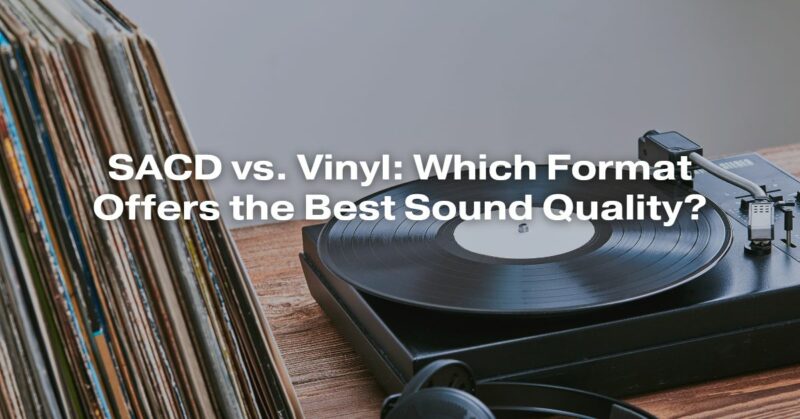In the world of audiophiles and music enthusiasts, the debate over which format offers the best sound quality has raged on for decades. Two formats that have consistently stood out in this debate are Super Audio CD (SACD) and vinyl records. Both formats have their dedicated fan base, and each has its unique characteristics that contribute to its appeal. In this article, we will delve into the world of SACD and vinyl, exploring their respective qualities and helping you decide which format might offer the best sound quality for your listening preferences.
Understanding SACD:
Super Audio CD, or SACD, is a digital audio format developed by Sony and Philips in the late 1990s. It was designed to provide high-resolution audio playback and improve upon the limitations of the standard Compact Disc (CD) format. SACDs typically contain audio in either stereo or multi-channel formats and have a significantly higher sampling rate than CDs, offering a potential for more detailed and accurate sound reproduction.
Pros of SACD:
- High Resolution: SACD boasts a higher sampling rate of 2.8224 MHz compared to the 44.1 kHz of CDs. This higher resolution can capture more audio information and detail, resulting in a potentially more lifelike and immersive listening experience.
- Low Noise Floor: SACDs tend to have a lower noise floor compared to vinyl records, which means less background noise or surface noise during playback.
- Multi-Channel Audio: SACDs often feature multi-channel audio, allowing for surround sound experiences. This is especially appealing for home theater enthusiasts.
- Durability: Unlike vinyl records, SACDs are not prone to wear and tear from repeated plays. They are also less susceptible to environmental factors like dust and humidity.
Cons of SACD:
- Limited Availability: SACDs have a relatively limited library compared to other formats, such as CDs or vinyl records. Finding specific SACD titles can be challenging.
- Specialized Equipment: To fully enjoy the benefits of SACD, you need a compatible player, which can be expensive. Not all SACD players are created equal, and high-quality ones can be quite costly.
- Digital Nature: Some audiophiles argue that SACD’s digital nature, while high in resolution, lacks the warmth and character of analog formats like vinyl.
Understanding Vinyl:
Vinyl records, also known as LPs (Long Play) or phonograph records, have been a staple of music playback for over a century. These analog recordings consist of grooves that, when played with a stylus, produce sound. Vinyl records have experienced a resurgence in popularity in recent years among both audiophiles and mainstream music lovers.
Pros of Vinyl:
- Warm and Analog Sound: Vinyl records are renowned for their warm, analog sound. They capture the nuances and imperfections of the original recording, providing a unique and often highly sought-after listening experience.
- Tangible and Collectible: Vinyl records offer a tactile and collectible aspect that appeals to many music enthusiasts. Album artwork and the physicality of records can add to the overall experience.
- Wide Selection: Vinyl records have a vast catalog of available titles, from contemporary releases to vintage classics. Finding and collecting vinyl is a hobby in itself.
- Affordable Entry: While high-end turntables and audio systems can be expensive, there are many budget-friendly options for vinyl playback, making it accessible to a wide range of consumers.
Cons of Vinyl:
- Surface Noise: Vinyl records are susceptible to surface noise, including pops, clicks, and hisses, which can detract from the listening experience. This noise can result from imperfections in the record or the stylus.
- Limited Dynamic Range: Vinyl records may have limitations in dynamic range, which can affect the ability to reproduce extremely quiet or loud passages accurately.
- Wear and Tear: Vinyl records degrade with each play, and improper handling or storage can lead to damage. They are also sensitive to environmental factors like temperature and humidity.
- Inconsistent Quality: Vinyl quality can vary greatly depending on factors like pressing quality, mastering, and vinyl thickness. Some reissues may not faithfully capture the original recording’s sound.
The Verdict:
The debate between SACD and vinyl ultimately comes down to personal preference and priorities in your listening experience. SACD offers high-resolution digital audio with low noise, making it a solid choice for those who value pristine sound quality and have the necessary equipment. Vinyl, on the other hand, provides a warm and analog sound that many find appealing, along with a tangible, collectible experience.
For audiophiles seeking the utmost in sound quality, SACD might have the edge in terms of technical specifications. However, vinyl’s unique character and nostalgic appeal can outweigh the technical advantages for those who appreciate the artistry and ritual of playing records.
In the end, the “best” format depends on your preferences and priorities as a music listener. Some collectors and enthusiasts even enjoy both formats, enjoying the best of both worlds in their quest for the ultimate listening experience. Ultimately, it’s the music itself that matters most, and both SACD and vinyl have their own distinct ways of bringing it to life.

